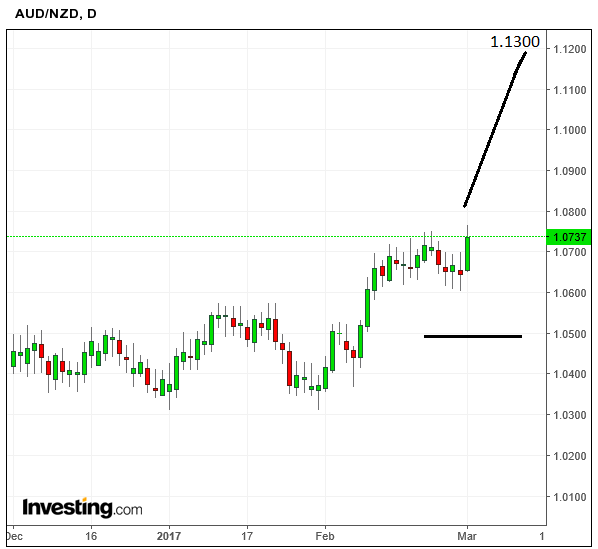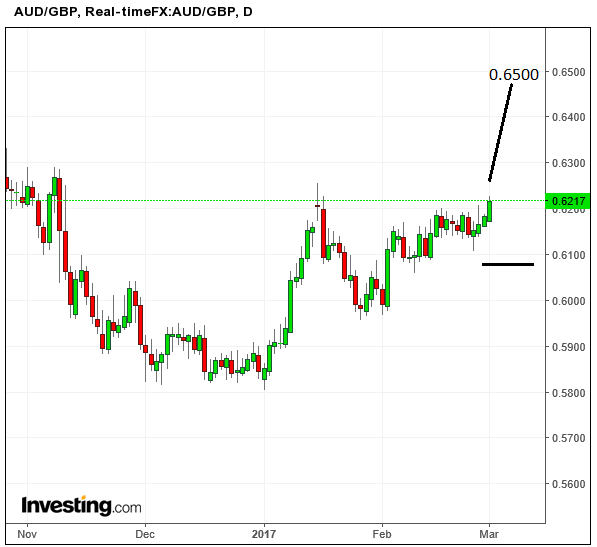Australian Dollar is a Buy Against the Pound and New Zealand Dollar with UniCredit but Another Analyst Warns of 'Dark Clouds on Horizon'

The Australian Dollar was the best-performing currency in the G10 at the start of the new month; a performance that comes as little surprise to those who have watched the currency put in such performances on a regular basis in 2017.
Indeed, against the US Dollar and Pound Sterling the Aussie is the best performer for 2017.
And, more of the same is likely argues Unicredit’s Global Head of FX Strategy Vaselios Gkionakis in a new strategst brief to clients.
“We like the AUD as the best proxy for the upswing in global activity currently underway,” says Gkionakis.
A reason to expect further outperformance comes down to the strong link between the Aussie and commodities, which although, stalling over the last few weeks, are broadly undergoing an upswing.
China is a major importer of Australian commodities and it has also defied negative expectations by showing an uptick in its surveys of purchasing managers, signalling the possibility of a general rebound in activity and growth, despite tighter credit conditions.
“Chinese PMIs surprised on the upside overnight, signalling the expansion is accelerating; and Australian GDP growth for 4Q16 came in stronger than expected at 1.1% qoq. Importantly, the household-savings ratio dropped to its lowest level since 2008, at 5.2%,” says Gkionakis.
These developments now mean that it is highly unlikely the Reserve Bank of Australia (RBA) will cut interest rates for the foreseeable future, which is likely to lead to a rise in the currency.
The previous expectation that the RBA would cut interest rates had resulted in forecasts for the Australian Dollar to weaken over time, however, given this is unlikely it may rise, or at least holds its ground.
Lower interest rates mean less international investors are likely to put their money into a country as they will get a lower return.
Strategy: Buy Aussie Using Pound and NZ Dollars
Unicredit are particularly bullish for the Aussie versus two currencies, the New Zealand Dollar and the Pound.
“Turning to the NZD: although we are constructive over the medium term, we think that there is scope for underperformance compared to the Aussie. In our view.”
Their thesis is that investors are currently overoptimistic about he New Zealand economy and foresee interest rates being lifted by a greater amount than will probably in reality happen.
They forecast AUD/NZD to rise to 1.1300 (from the current 1.0737) but would pull out of the trade at 1.0500.

They are also bullish the Australian Dollar versus the Pound, expecting Sterling to weaken on worsening data.
“The drop in the manufacturing PMI in February marked the biggest monthly decline since July (right after the referendum result); this is important because it is happening against a backdrop of rising PMIs globally. We think the market is likely to interpret this divergence as the potential beginning of a slowdown in the domestic economy, at a time when globally activity maintains strong momentum,” says Gkionakis.
UniCredit forecast AUD/GBP rising to 0.65 (from current 0.6217), and would pull out of the trade if it fell below 0.6080.

From a GBP into AUD perspective this equates to a decline to 1.5384 from 1.6084 with the stop-loss being set higher at 1.6447.
Beware, the Australian Dollar Could be Overvalued
Just as UniCredit are throwing their lot in with the Australian Dollar, analyst Peter Rosenstreich at Swissquote Bank in Gland, Switzerland tells us he is concered about the currency's valuation.
Indeed, he reckons that dark clouds are forming on the horizon as the strong demand by China for Australian iron ore is likely to fade over coming months.
"Dark clouds are gathering on the horizon," says Rosenstreich noting China’s iron ore port inventory rose dramatically this year and reached almost 130 million tons as of February 24th.
"On the other hand, over the same period, steel production continued to inch lower, suggesting that there is a strong imbalance between demand and supply," says Rosenstreich.
Iron ore is Australia's largest export accounting for around 20% of GDP and its dependence on China’s health is also very high as roughly 34% 12-month average of its exports go to China.
Further, on a trade-weighted basis the Aussie is back to levels last seen in summer 2015, which makes the RBA very unhappy with the situation.
"Indeed, the central bank has reiterated many times that the Aussie is overvalued and may be ready to take some action to adjust this situation. Taking into account the two factors exposed above, we believe that the Aussie rally has come to an end and that a correction is looming," warns Rosenstreich.





